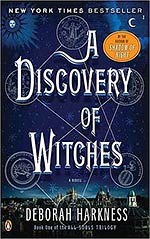
![]() Rhondak101
Rhondak101
1/2/2013
![]()
Somewhere online I read that A Discovery of Witches is “Harry Potter for adults.” Similarly, I described the book to a relative as “Twilight for smart people.” (Since I've never read any of the Twilight series, I'll accept any of the invective that you want to pile on for my snobbery). However, a book like this will inevitably be compared to these two behemoths of popular culture. Magic? Check. A brooding vampire? Check. A forbidden romance? Check. A movie deal in the works? Check.
Deborah Harkness freely admits that the current magic-and-vampire craze inspired her to write A Discovery of Witches. She remembers walking through an airport bookstore and wondering if there are witches and vampires, what do they all do for a living? In response to that question, she gives us Diana Bishop, a Yale history professor and the last of a long line of American witches, and Matthew Clairmont, a neuroscientist, a fellow of All Souls, Oxford, and a vampire. Diana Bishop, in response to a childhood trauma, vows to give up all magic and buries herself in her research. Significantly, she researches early alchemical manuscripts, trying to show “how scientific this pursuit really was” (10). Her belief is that “[a]lchemy tells us about the growth of experimentation, not the search for a magical elixir that turns lead into gold and makes people immortal” (10). While working in the Bodleian Library, Diana uncovers Ashmole 782, a bewitched alchemical manuscript. When the manuscript does not fulfill her scholarly needs, she sends it back to the stacks and eschews its layers of magical writing. Her discovery of this once-thought lost manuscript suddenly makes the Bodleian Library an epicenter for the three species of supernatural creatures that inhabit Harkness' world, witches, vampires and daemons. Each species imagines this lost manuscript as something different, but each species holds the common belief that it will provide knowledge about their origins and reveal their connections to the other two magical species as well as humans. Therefore, each species would do anything to possess the manuscript.
Deborah Harkness is very much like her protagonist. She is a history professor who teaches at the University of Southern California. Her two scholarly publications, John Dee's Conversations with Angels: Cabala, Alchemy, and the End of Nature and The Jewel House: Elizabethan London and the Scientific Revolution, could have been written by Diana Bishop. Even more like Diana, in 1994 Harkness “discovered” two copies of the considered-lost Book of Soyga, a sixteenth-century book of spells used by John Dee; one was located in the British Library and the other in the Bodleian. The manuscripts were catalogued under a different title, and Harkness connected them to famous book used by Dee.
Because of Harkness' specialties, A Discovery of Witches looks at magic, witchcraft, vampirism, and daemonism from the contexts of history and science, delving into biology, genetics, and evolution. She creates complex mythologies for each type of creature, basing some of our commonly held beliefs about witches and vampires in biology and human psychology. In her mythology, vampires are made by other vampires and become a part of a dynastic line. Witches are born to other witches with genealogical lines stretching back to one of the five daughters of a mitochondrial Lillith, the first witch. Daemons are born to human parents and demonstrate “a superabundance of cleverness and creativity” (55) and “walk a tightrope between madness and genius” (17). Diana's aunt describes them as “rock stars or serial killers” (17).
Most of the characters in the book hit all the correct archetypal notes without seeming hackneyed. Besides Diana and Matthew, there are the perpetually-worried witch-aunts, Sarah and Em; the ice-queen with a heart of gold mother vampire, Ysabeau; the capable and caring family retainer, Marthe; and Hamish, the rich-as-Creosus daemon best friend. (For those of you who read Martha Grimes' Richard Jury mysteries, he reminds me very much of Melrose Plant.) These archetypal figures are the most entertaining when the families start to mix and give a new definition of “blended” family. Some of the scenes when the vampires visit the witches in upstate New York are hilarious. The Bishop House not only contains ghosts of past Bishops but also has its own personality, welcoming or banning those it likes or dislikes by offering keys or slamming doors. When the House senses that its already full self will get more visitors, it adds a room of its own accord.
There's much to like about this book. The characters are fun, and Harkness weaves interesting connections between lines of alchemical verse, genetics, and evolutionary biology. Nevertheless, the middle third of the book is full of more angst and pent-up desire than I thought I could take. However, the payoff in the last third is worth it as additional interesting characters appear, humor plays a more significant role, and the scientific discourse returns. The book ends in a cliffhanger with Diana and Matthew traveling back in time so that they can learn the secret of Ashmole 782 and so that Diana can find a tutor to teach her to control her substantial magical gifts. While this time-traveling is set-up through the different types of powers Harkness' witches can possess, this twist at the end both concerns and excites me. My excitement in seeing this historian's vision of the past outweighs my concerns over a clichéd time travel plot. I will definitely read the sequel Shadow of Night with the hope that since Diana and Matthew are a couple the adventure plot will trump frequent examination of the lovers' desires.